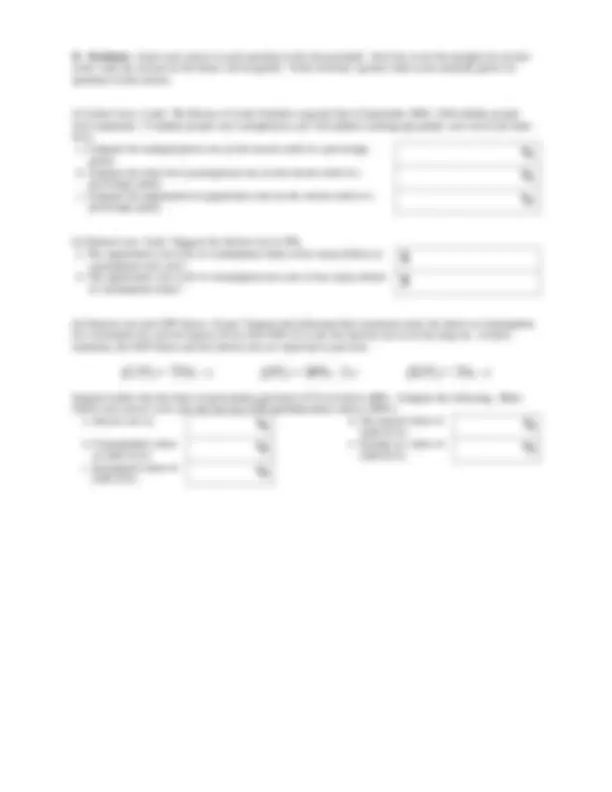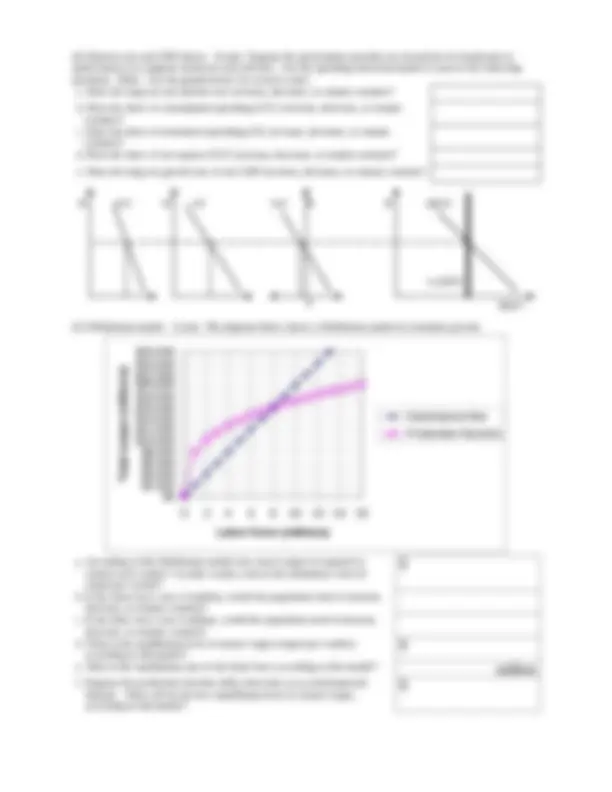





Study with the several resources on Docsity

Earn points by helping other students or get them with a premium plan


Prepare for your exams
Study with the several resources on Docsity

Earn points to download
Earn points by helping other students or get them with a premium plan
Community
Ask the community for help and clear up your study doubts
Discover the best universities in your country according to Docsity users
Free resources
Download our free guides on studying techniques, anxiety management strategies, and thesis advice from Docsity tutors
A midterm exam for an econ 001: principles of macroeconomics course offered at drake university in the fall of 2005. The exam covers topics such as long-run economic growth, inflation, potential gdp, real gdp, gross investment, depreciation, interest rate, consumption, investment, net exports, labor force, employment-to-population ratio, opportunity cost, malthusian model of economic growth, technical change, money, money multiplier, and velocity of money.
Typology: Exams
1 / 7

This page cannot be seen from the preview
Don't miss anything!




Principles of Macroeconomics (Econ 001) Signature: Drake University, Fall 2005 William M. Boal Printed name:
INSTRUCTIONS: This exam is closed-book, closed-notes. Simple calculators are permitted, but graphing calculators or calculators with alphabetical keyboards are NOT permitted. Numerical answers, if rounded, must be correct to at least 3 significant digits. Point values for each question are noted in brackets. Maximum total points are 100. I. Multiple choice: Circle the one best answer to each question. [2 pts each, 34 pts total] (1) In August, at the beginning of this semester, we were in the _______ quarter of 2005. a. first. b. second. c. third. d. fourth. (2) According to the aggregate production function, potential GDP is determined by all of the following except a. technology. b. the size of the labor force. c. the size of the capital stock. d. total spending. (3) Real GDP grows faster in the long run, the higher the fraction of total spending on a. government purchases. b. net exports. c. consumption. d. investment. (4) Suppose the capital stock at the beginning of 2005 was $9 trillion. Also suppose that during 2005, gross investment is $1.5 trillion and depreciation is $1.2 trillion. Then the capital stock at the beginning of 2006 will be a. $9.3 trillion. b. $10.2 trillion. c. $10.5 trillion. d. $12.7 trillion. (5) Investment spending is a. negatively related to the real interest rate. b. unrelated to the real interest rate. c. positively related to the real interest rate. d. cannot be determined from information given. (6) If the interest rate falls in the United States, net exports rise because a. exporters can borrow money more easily. b. the dollar appreciates. c. the dollar depreciates. d. consumers decrease their total spending. (7) If a person does not have a job, and last looked for work two weeks ago, that person would be classified by the Bureau of Labor Statistics as a. employed. b. unemployed. c. out of the labor force. d. cannot be determined from information given. (8) "Job rationing" theories of unemployment predict that unemployment could be reduced if a. workers were notified of plant closings in advance. b. government helped match unemployed workers with employers. c. wages were increased. d. wages were reduced. (9) Since 1700, long-run growth rates of real GDP per capita in the fastest-growing countries have a. remained about zero. b. remained constant, though positive, from one century to the next. c. decreased from one century to the next. d. increased from one century to the next.
Principles of Macroeconomics (Econ 001) Drake University, Fall 2005 Midterm Examination #3 Version B
(10) A country experiences faster "embodied" technical change, the a. larger the existing stock of capital already in place. b. more workers ("bodies") are available to use it. c. faster new plant and equipment are built, installed, and put to use. d. more training workers receive. (11) "Human capital" means a. education and training of workers. b. retirement savings plans for workers. c. people-friendly businesses. d. ergonomically designed equipment. (12) Suppose a new idea for making office work more efficient is so broad and general that it cannot be patented. This new idea is a. a nonexcludable good. b. a nonrival good. c. a private good. d. a transfer. (13) The three essential functions of money include all of the following except a. store of value. b. unit of account. c. method for reducing government deficits. d. medium of exchange. (14) When banks keep reserves on deposit with the Federal Reserve, those funds earn an interest rate a. of zero. b. slightly below the market rate. c. equal to the market rate. d. greater than the market rate. (15) According to the quantity equation, if the money supply grows more slowly than the growth rate of real GDP, the inflation rate will be a. positive. b. negative (deflation). c. zero. d. cannot be determined from information given. (16) If the money supply grows rapidly, the likely consequence is a. high unemployment. b. rapid growth of real GDP. c. hyperinflation. d. a fall in the real interest rate in the long run. (17) Most economists believe that a higher rate of inflation will, in the long run, bring a. a lower rate of unemployment. b. no change in the rate of unemployment. c. a higher rate of unemployment. d. cannot be determined from the information given.
II. Problems: Insert your answer to each question in the box provided. Feel free to use the margins for scratch workonly the answers in the boxes will be graded. Work carefullypartial credit is not normally given for questions in this section. (1) [Labor force: 6 pts] The Bureau of Labor Statistics reported that in September 2004, 139.6 million people were employed, 7.5 million people were unemployed, and 76.8 million working-age people were not in the labor force. a. Compute the unemployment rate (to the nearest tenth of a percentage point).
b. Compute the labor force participation rate (to the nearest tenth of a percentage point).
c. Compute the employment-to-population ratio (to the nearest tenth of a percentage point).
(2) [Interest rate: 4 pts] Suppose the interest rate is 3%. a. The opportunity cost of $1 of consumption today is how many dollars of consumption next year?
b. The opportunity cost of $1 of consumption next year is how many dollars of consumption today?
(3) [Interest rate and GDP shares: 10 pts] Suppose the following three equations relate the shares of consumption (C), investment (I), and net exports (X) in total GDP (Y) to the real interest rate (r) in the long run. In these equations, the GDP shares and the interest rate are expressed as percents.
Suppose further that the share of government purchases (G/Y) is fixed at 20 %. Compute the following. [Hint: Check your answer to be sure that the four GDP spending shares sum to 100%.] a. Interest rate (r)
d. Net exports' share of GDP (X/Y):
b. Consumption's share of GDP (C/Y):
e. Savings as a share of GDP (S/Y):
c. Investment's share of GDP (I/Y):
(4) [Interest rate and GDP shares: 10 pts] Suppose the government provides tax incentives for businesses to spend money on computer hardware and software. Use the spending allocation model to answer the following questions. [Hint: Use the graphs below for scratch work.] a. Does the long-run real interest rate increase, decrease , or remain constant? b. Does the share of consumption spending (C/Y) increase, decrease , or remain constant? c. Does the share of investment spending (I/Y) increase, decrease , or remain constant? d. Does the share of net exports (X/Y) increase, decrease , or remain constant? e. Does the long-run growth rate of real GDP increase, decrease , or remain constant? (5) [Malthusian model: 12 pts] The diagram below shows a Malthusian model of economic growth.
a. According to this Malthusian model, how much output is required to sustain each worker? In other words, what is the subsistence level of output per worker? $ b. If the labor force were 12 million, would the population tend to increase, decrease, or remain constant? c. If the labor force were 4 million, would the population tend to increase, decrease, or remain constant? d. What is the equilibrium level of annual wages (output per worker) according to this model? $ e. What is the equilibrium size of the labor force according to this model? (^) million f. Suppose the production function shifts down due to an environmental disaster. What will be the new equilibrium level of annual wages, according to this model? $
III. Critical thinking: Write a one-paragraph essay answering one question below (your choice). Full credit requires correct economic reasoning, legible writing, good grammar including complete sentences, and accurate spelling. [4 pts] (1) Consider the following statement. "The world is getting more and more crowded. Soon we will run out of natural resources and economic growth will stop." Do you agree or disagree? Why or why not? Cite the historical record. (2) Suppose we had no currency or checking deposits and had to find a new form of money. Evaluate the following alternatives: (1) fresh pears, (2) lumber, (3) candy bars. Which would be best? Why? Which question are you answering, (1) or (2)? _________. Please write your answer below: [end of exam]